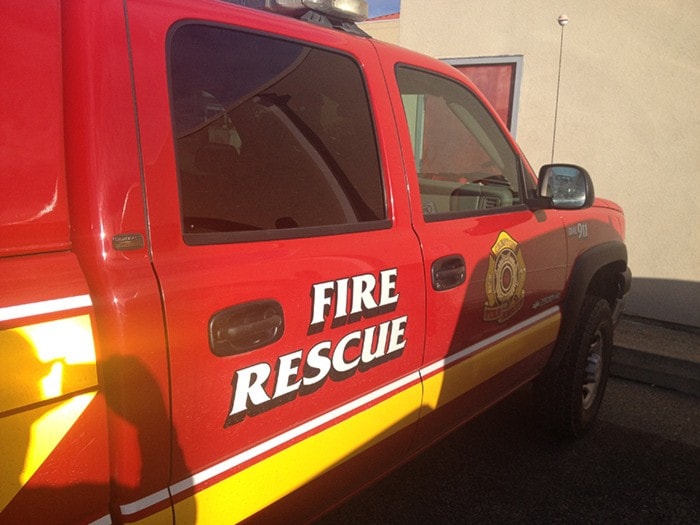Creston town council gave fire Chief Mike Moore the go-ahead to shop for a ladder truck at Tuesday's regular council meeting.
With an agreement to provide fire protection services to West Creston on the horizon, Creston Fire Rescue has reassessed its fleet, identifying what Moore has described as “an opportunity” to add a ladder truck (or quintuple aerial apparatus — pump, water tank, fire hose, aerial device and ground ladders) to the mix.
When the contract is place and a building is constructed, Creston Fire Rescue will have to keep a fire engine in place in West Creston. Moore proposes to move one of its two fire engines to the new fire hall, and to replace it with a unit that provides more and better firefighting options.
Council approved an expenditure not to exceed $280,000, which will be funded from a fire department capital reserve fund, the town’s general reserves, proceeds from the reduction to one rescue truck from the current two and Regional District of Central Kootenay Area C payment for contract firefighting services.
The plan is all part of Moore’s stated goal of improving the municipality’s Public Fire Protection Classification from its present low level of eight to five, which would likely result in insurance savings for town residents.
“Adding an aerial truck doesn’t guarantee the classification would be improved, but it is a major factor,” Moore told council.
He said he would be working this year to identify what other steps need to be taken to improve the fire protection rating.
A ladder, or aerial, truck has several benefits, including giving firefighters the ability to spray water onto a fire from above, rather than from the side. It also gives firefighters direct access to work on roofs and it can be of value in rescue efforts. An aerial truck of the type Moore is recommending could have been used in the rescue of an injured youth below the Canyon bridge last year, he said. In that rescue, a volunteer sustained back injuries as he was lowed by ropes to get to the victim.
The contract to provide West Creston with certified fire protection requires placement of a fire engine valued at approximately $90,000, he said.
“Fire Underwriters Survey (FUS) requires a minimum of one fire engine with a minimum 840 gallons per minute pump and 500-gallon water tank capacity,” he said.
A purchase of a used unit that could be utilized for about 10 years and that meets this requirement is valued at $70,000-$90,000US.
Instead of purchasing a used unit to meet those requirements, Creston Fire Rescue will move its 2001 GMC Superior fire engine to West Creston and replace it in Creston with the aerial unit.
“The insurance industry (FUS) recommends that a community utilize an aerial apparatus when a community has five buildings that are three stories or 35 feet or more in height, or a district that has a basic fire flow water requirement greater than 3,300 gallons per minute, or any combination of these criteria,” Moore said.
“From a firefighter safety perspective, an aerial apparatus assists in providing firefighters with the required means of egress or ‘escape access’ from buildings two stories or higher. When firefighters enter buildings on fire, it is required that two controlled means of egress must be provided. One is the protected access through which the firefighters entered the building, the other needs to be controlled by the fire department. This requires providing ladders on a building exterior to reach floors where firefighting activities are taking place.
“At present, the fire department has one ground ladder, which reaches some third floors of buildings and is very labour intensive to deploy. This operational challenge creates delays to safety put firefighters into buildings where the fire is above the second floor.”
He summarized the benefits in having aerial apparatus, which offers the ability to:
•provide a large volume of water flow directly to the fire, from above the fire, with minimal firefighters for deployment. This improves exposure protection to neighbouring buildings and the ability to sufficiently knock fires down;
•provide water to firefighter hand lines above grade 2 (two storeys or higher) without extending hoses from the truck through the building and stairwells. This improves setup time and limits water friction loss through long hose lays;
•provide means of egress or secondary exit to firefighters on all buildings above two storeys quickly and efficiently during fire operations;
•provide firefighter safety during room operations for vertical ventilation, in some instances providing opportunity for ventilation to created without the firefighter leaving the aerial device;
•safely place large volumes of water to high-heat fires, such as a sawmill;
•safely and efficiently place firefighting equipment on roofs or floors above grade;
•utilize for rescue during firefighting on floors above grade; and
•utilize for technical rope rescue incidents.
A new aerial truck cost about $650,000US. Moore illustrated his presentation with information about three used trucks in the U.S., all of which are listed for under $220,000US. Many of the used trucks on the market today cannot be considered, he said, because the Creston fire hall is a low building with doors that have an 11-foot 10-inch clearance.
“I would like to ask the director of finances for his opinion on this purchase,” Coun. Kevin Boehmer said during the council debate about the motion to approve the purchase.
Finance director Steffan Klassen said he had input in the presentation and that the figures provided by Moore were accurate.
“It comes to a decision about the direction that council wants to take,” he said.
Council approved the motion unanimously.
With the mutual aid agreement in place with regional fire departments, the aerial until would be available as needed throughout most of the Creston Valley.
This is the fourth story in a series about fire service in Creston. Previous installments discussed the amount of local calls and potential financial impact, the link between fire services and insurance rates, and the fire department’s work experience program.
